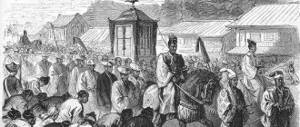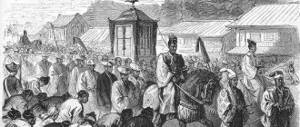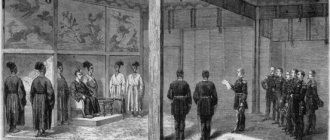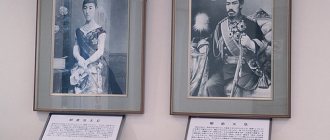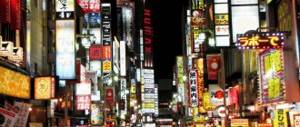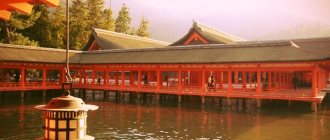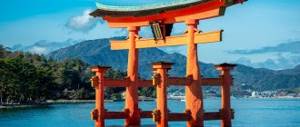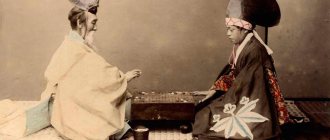5K 17 min.
Despite his addiction to alcohol, Emperor Mutsuhito remained firmly in the saddle
140 years ago, in 1867, Emperor Mutsuhito ascended the Japanese throne, under which Japan transformed from a feudal country into a dynamically developing industrial power. The success of the reforms he initiated was explained, in particular, by the fact that the Japanese readily admitted their backwardness and did not look for their “special path” until they had learned the experience of others.
"Black Ships"
Today it is difficult to believe that there was a time when the Japanese were ashamed of their own country, including their cultural heritage. Japan went through a period of self-deprecation in order to stand on par with industrialized countries - this was the Meiji era, named after the motto of the reign of Emperor Mutsuhito, who himself went down in history as Emperor Meiji.
The future reforming monarch was born on November 3, 1852 at the Imperial Palace in Kyoto. Mutsuhito was the son of Emperor Komei and his concubine Yoshiko. Although she was not the official wife of the emperor, Mutsuhito was considered a prince under Japanese law, and since the other Komei children died in early childhood, Mutsuhito eventually became the only contender for the Chrysanthemum Throne. However, at that time in Japan, being an emperor did not mean ruling the country. Since ancient times, the emperor, considered a descendant of the gods, and the court aristocracy were engaged only in the performance of numerous religious rituals designed to provide the country with peace, good rice harvests and protection from earthquakes, while real power was in the hands of the shoguns - military dictators from the most powerful samurai clans Since the 17th century, the state was ruled by shoguns from the Tokugawa clan, whose residence was located in Edo (present-day Tokyo), and the emperors were isolated in Kyoto and did not even have the right to leave their palace. The Tokugawa, who came to power as a result of a bloody civil war, considered it their duty to ensure peace and tranquility for the country, and they succeeded in this for two and a half centuries. The Shogunate stopped endless feudal wars, introduced a strict class system in which everyone knew their place, minimized contact with foreigners and even forbade the Japanese to leave their native shores. The flip side of stability and peace was stagnation, and in the 19th century Japan had to realize the consequences of falling behind in technological progress.
The samurai were excellent fencers and archers, but they were completely powerless against armies trained in the European way.
The crisis began when Prince Mutsuhito was just learning to walk. On July 8, 1853, an American squadron under the command of Commodore Matthew Perry approached the shores of Japan, who in the form of an ultimatum demanded the establishment of diplomatic and trade relations with the United States. The Shogunate was shocked by the audacity of the barbarians, as the Japanese called representatives of Western civilization, and also by the fact that there was absolutely nothing to oppose the Americans. Since the shoguns themselves had banned the construction of large ships back in the 17th century to prevent their subjects from sailing too far, the country's naval forces were a pitiful sight. Suffice it to say that the largest Japanese ship had a displacement of 150 tons versus 2450 tons for the flagship of the Perry squadron. In addition, the Japanese had before their eyes the example of China, which, despite its inexhaustible human resources, was defeated by the British during the “Opium War,” so the shogunal government understood perfectly well that the samurai militia could not resist the regular army. As a result, the shogunate agreed to the American demands, and in 1854, Japan and the United States signed a “treaty of friendship” that granted America most favored nation status. Thus, the regime admitted its impotence, and soon a powerful opposition bloc began to emerge in the country, headed by Emperor Komei, who seemed to be forever eliminated from the political arena.
In fact, the shogun's government opened Japan to foreigners, but the emperor sincerely believed that its sacred land should not be trampled under the feet of wicked barbarians. The slogan of fighting foreigners turned out to be very popular, since it was with their appearance that serious problems began in the country’s economy. In isolated Japan, gold was relatively cheap; one gold piece was worth five silver coins of the same weight, while in neighboring China - 15. European merchants, who gained access to Japan thanks to the Americans, began to buy cheap Japanese gold, which led to its rapid rise in price, and gold pulled down the prices of silk and tea. Prices for all basic products began to rise, and for the Japanese it was obvious who was to blame.
On the side of the emperor were the samurai clans Satsuma and Choshu, who ruled the southwestern part of the country and dreamed of depriving the Tokugawa house of power. Despite their hatred of foreigners, these clans had troops trained in the European style, which provided a serious advantage over the armed forces of the shogunate. Moreover, representatives of these clans, who occupied a prominent place at the emperor’s court, believed that Japan needed to rebuild itself along the Western European model in order to give a worthy rebuff to the “black ships” of Commodore Perry. As a result, a paradoxical situation arose: the party, which accused the shogunate of kowtowing to the West, sought to put this kowtowing into practice.
Genealogy[ | ]
| (114) Nakamikado | (115) Sakuramachi | (117) Go-Sakuramachi | |||||||||||||||||||||||||||||||||||||||||||||
| (116) Momozono | (118) Go-Momozono | ||||||||||||||||||||||||||||||||||||||||||||||
| Naohito | Sukehito | Haruhito | |||||||||||||||||||||||||||||||||||||||||||||
| (119) Kokaku | (120) Ninko | (121) Komei | (122) Meiji | ||||||||||||||||||||||||||||||||||||||||||||
| Sukehira | Chikako | ||||||||||||||||||||||||||||||||||||||||||||||
| (122) Mutsuhito Meiji period 1867–1912 (1852—1912) | (123) Yoshihito Taisho period 1912–1926 (1879—1926) | (124) Hirohito Showa period 1926–1989 (1901—1989) | (125) Akihito Heisei period 1989—2019 (born 1933) | (126) Naruhito Reiwa period from 2019 (born 1960) | ||||||||||||||||||||||||||||||||||||||
| Yasuhito (1902—1953) | Masahito (b. 1935) | Fumihito (b. 1965) | Hisahito (b. 2006) | |||||||||||||||||||||||||||||||||||||||
| Nobuhito (1905—1987) | Tomohito (1946—2012) | |||||||||||||||||||||||||||||||||||||||||
| Takahito (1915—2016) | Yoshihito (1948—2014) | |||||||||||||||||||||||||||||||||||||||||
| Norihito (1954—2002) | ||||||||||||||||||||||||||||||||||||||||||
"Just unbutton your pants"
When Emperor Komei died on December 25, 1866, either from smallpox or arsenic, the country was already on the verge of civil war. The heir to the throne, Mutsuhito, was only 15 years old at that time, and he did not and could not have any opinion about the situation in the state. Mutsuhito was brought up in the greenhouse conditions of the palace, received a purely medieval education, and even then he was not too zealous in his studies. Thus, despite the fact that one of the main subjects studied at court was calligraphy, Mutsuhito’s success in it left much to be desired, and his handwriting remained illegible. And yet it was Mutsuhito who was destined to lead the reform party.
Even during the reign of Komei, the Japanese elite realized how great the country was lagging behind the West, which was facilitated by a careful study of the potential enemy. First of all, the Japanese were captivated by the toy railway that Perry presented to the shogun's court. The small carriages were only suitable for riding on horseback, but Edo dignitaries fully appreciated the importance of the steam engine. Already in 1860, the Japanese embassy visited the United States for the first time, where it purchased many books on the natural sciences. The Japanese did not like America, because a country where there is no clear class division, and the president dresses like some kind of merchant, can only be barbaric. But railways, telegraphs and other achievements of technical progress made an indelible impression on the members of the delegation.
Soon writings appeared in Japan that extolled the Western way of life. They even gave specific instructions on how to be European. Thus, one of the books told how civilized people go to the toilet: “You should relieve yourself as follows. For minor needs, simply unbutton your trousers. To relieve yourself of great need, you should unfasten the suspenders in front and behind; putting them on again is quite inconvenient and troublesome.” The purpose of the chamber pot was explained separately in order to prevent a repetition of the mistakes of the 1860 embassy, when some Japanese diplomats used the pot as a headrest when going to bed. But since the shogunate did nothing to lift the country out of its feudal rut, supporters of modernization pinned their hopes on the young emperor. All that remained was to overthrow the shogun and transfer all power to the heir Komei.
Mutsuhito took away not only power from the shogun - in his era, the shogun's castle in Edo began to be called the imperial palace in Tokyo
Mutsuhito became emperor on February 3, 1867, and for the first time in centuries, a Japanese monarch had a serious military force on his side. Smart, not without political foresight, shogun Yoshinobu, the head of the Tokugawa clan, tried to maneuver, but the reform party, supported by the samurai of Satsuma and Choshu, did not want compromises, and already in January 1868, civil war broke out in Japan. Thanks to the European training of the Satsuma army, the shogun's troops were defeated, despite their threefold numerical superiority, and the fate of the shogunate was finally decided. It is noteworthy that the army that fought under the imperial banner was commanded by the Satsuma commander Saigo Takamori, an enemy of everything foreign, who later led the most powerful samurai uprising against modernization.
Finally, Yoshinobu finally abdicated power, and the reform party, grouped around the throne of Mutsuhito, was able to begin implementing its program. The reforms began with the ceremony of taking the imperial oath, which took place on March 14, 1868. The emperor, contrary to the custom that forbade his subjects to see him, did not isolate himself from those present with a traditional curtain, which already looked like a small revolution. In addition, Mutsuhito promised to eliminate the “bad customs of the past”, allow his subjects to govern the country, and also announced that from now on “knowledge will be acquired throughout the world.” In addition, the emperor himself moved to live in Tokyo, as Edo now became known, which also indicated the beginning of a new era. The Meiji era, that is, the era of enlightened rule, was proclaimed in Japan. Subsequently, it became common for Mutsuhito himself to be called Emperor Meiji.
Typically, major reformers pursue their policies based on the bright image of a more or less distant past, and Japanese reformers were no exception. The idea of returning to the semi-mythical era that preceded the shogunate, when all power supposedly belonged to the emperor, was put into motion. According to the existing tradition, the feudal princes, who reigned supreme in their domains, at the beginning of the reign of each shogun officially “handed over” their lands to the new ruler, who immediately returned them back, thereby confirming the privileges of the feudal lords. However, this time a surprise awaited the princes - the young emperor, after formally transferring the lands to him, declared them his property, relying on the slogan of a return to the “unclouded past” of the pre-Shogun era.
Before the Meiji era, there was only one railway in Japan, and that was a toy one.
At first, however, the princes were allowed to remain in their possessions as hereditary governors, but in 1871 the principalities were liquidated, and in their place prefectures arose, headed by officials who were on government pay. The fight against old privileges did not end there. Back in 1870, commoners were allowed to acquire surnames, which was previously allowed only to the samurai class, and in 1871, the samurai themselves were “allowed” to abandon two swords and a characteristic hairstyle. The samurai grumbled, but for the time being, their discontent was at least managed to be extinguished with the help of state pensions and the distribution of posts in the new army and police. However, the best places went to people from the Satsuma and Choshu clans, so the samurai still rebelled from time to time, and after the failure of the rebellion, as usual, they committed hara-kiri. But the authorities did not even think of giving in: in 1872, the old class division was completely abolished, and equality before the law of all inhabitants of the empire was proclaimed.
At the same time, the government was zealous in the economic field. In 1870, a single currency was introduced - the yen, pegged to the silver and then to the gold standard. Before that, in Japan, in addition to gold and silver coins, dozens of various banknotes were in circulation, which were used in individual principalities, cities and regions. Now order was restored, however, inflation haunted the Japanese for a long time. The issue of filling the treasury was also resolved. In the early years of the Meiji reign, the main source of funding for government activities was the confiscated lands of the Tokugawa clan, taxes from which went to the state coffers; After the liquidation of principalities, tax revenues of this kind increased many times over. True, these taxes were paid mainly in rice, so in 1873 a single cash tax on land was introduced in the amount of 3% of its value, which from now on amounted to about 80% of all budget revenues. For peasants, paying the land tax meant parting with half the harvest, but there was still not enough money to carry out large-scale reforms, as a result of which the government gradually introduced new taxes and increased old ones. Thus, taxes appeared on the sale of sake, rice, soybean oil, etc., as well as stamp duty. The tobacco monopoly also brought in decent amounts.
Tea and silk have long formed the basis of Japanese exports, while mainly equipment, technologies and new ideas were imported
But the most successful event was the capitalization of pensions that the state paid to former princes and samurai, including in rice. In 1876, the samurai were paid a lump sum pension for several years in advance. Moreover, half of the amount was issued in cash, half - in government bonds with an interest rate of 5-7% per annum. The total amount of payments was about 173 million yen. Those who received pensions invested them in banks created by the government, and the banks lent to the government. The monetization of samurai pensions allowed the treasury to get rid of a burdensome expenditure item and at the same time form a banking sector, which, in turn, provided financing for the reforms. Domestic loans alone, of course, were not enough, and from time to time it was necessary to take money abroad, but the government did not incur large debts, since the costs of reforms could be transferred to the shoulders of disciplined and unpretentious subjects.
Particular care was taken with regard to transport and communications. In 1870, the country's first telegraph line was opened between Tokyo and Yokohama, where a large colony of foreign businessmen was located, and two years later the first railway in Japan connected these cities. The population mastered innovations with difficulty. Some, having heard that the telegraph was faster than ordinary postal couriers, climbed telegraph poles and tied letters and parcels to the wires. The trains had their problems. Some passengers, accustomed, as Japanese custom dictates, to taking off their shoes before entering a home, took off their shoes before entering the carriage. Many of them were very upset when they did not find it at their destination.
They didn't forget about school. In 1872, a universal education system was created in Japan. All children aged 6 to 10 years were required to complete 32 weeks of schooling each year. There were also higher schools, in which education was not compulsory, as well as universities. Of all the reforms of the Meiji era, the school reform turned out to be one of the most successful: by the end of the 19th century, about 80% of Japanese children went to school - an unattainable figure for Russia at that time, for example.
At the head of all this hectic activity were imperial ministers such as Ito Hirobumi, Okubo Toshimichi, Kido Takayoshi, Mori Arinori. But the emperor himself did not play a secondary role in governance—the last word, one way or another, always remained with him. In general, he was a rather ordinary person who loved to listen to the gramophone, watch a military parade and have a good drink. However, Mutsuhito had the gift of listening carefully to his gifted ministers - having penetrated into the essence of the matter, he sometimes boldly accepted their most radical proposals.
Notes[ | ]
- ↑ 12
Mutsuhito // Brockhaus Encyclopedia (German) - ↑ 1 2 Brozović D., Ladan T.
Mutsuhito // Hrvatska enciklopedija (Croatian) - LZMK, 1999. - 9272 p. — ISBN 978-953-6036-31-8 - https://query.nytimes.com/mem/archive-free/pdf?res=9D05E3DB1F3CE633A25750C1A9669D946396D6CF Archived copy March 14, 2021 on the Wayback Machine “The Funeral Ceremonies of Meiji Tenno” reprinted from the Japan Advertiser
,]
New York Times.
13 October 1912. - Jansen, 1995, p. 7.
- Gordon, 2003, p. 14–15.
- Meshcheryakov, 2009, p. 19.
- Keen, 2002, p. 3.
- Gordon, 2003, p. 3–4.
- ↑ 123
Gordon, 2003, p. 2. - Meshcheryakov, 2009, p. 21.
- Gordon, 2003, p. 4–5.
- Meshcheryakov, 2009, p. 18.
- Meshcheryakov, 2009, p. 32.
- Meshcheryakov, 2009, p. 6.
- Gordon, 2003, p. 19.
- Gordon, 2003, p. 47.
- ↑ 12
Meshcheryakov, 2009, p. 29. - Keen, 2002, p. 10.
- Keen, 2002, p. 14.
- Meshcheryakov, 2009, p. 31.
- Keen, 2002, p. 7.
- ↑ 12
Meshcheryakov, 2009, p. 61. - ↑ 12
Gordon, 2003, p. 50–51. - Keen, 2002, p. 18.
- Meshcheryakov, 2009, p. 46.
- Meshcheryakov, 2009, p. 52.
- Meshcheryakov, 2009, p. 65.
- Keen, 2002, p. 39–41.
- Meshcheryakov, 2009, p. 71.
- Keen, 2002, p. 51–52.
- Keen, 2002, p. 46.
- Meshcheryakov, 2009, p. 78.
- Keen, 2002, p. 48.
- Meshcheryakov, 2009, p. 76.
- Gordon, 2003, p. 53–55.
- ↑ 12
Gordon, 2003, p. 55–56. - Keen, 2002, p. 73.
- Keen, 2002, p. 78.
- Gordon, 2003, p. 57–58.
- Meshcheryakov, 2009, p. 151.
- Keen, 2002, p. 94–96.
- Keen, 2002, p. 98.
- Keen, 2002, p. 102–104.
- ↑ 123
Gordon, 2003, p. 59. - Keen, 2002, p. 121.
- Keen, 2002, p. 117.
- Keen, 2002, p. 105–107.
- Meshcheryakov, 2009, p. 249.
- Keen, 2002, p. 133.
- Jansen, 1995, p. 195.
- Keen, 2002, p. 143.
- Keen, 2002, p. 145–146.
- Keen, 2002, p. 147.
- Keen, 2002, p. 171.
- Keen, 2002, p. 157–159.
- Keen, 2002, p. 160–163.
- Gordon, 2003, p. 68.
- Keen, 2002, p. 163–165.
- Keen, 2002, p. 168.
- Gordon, 2003, p. 64.
- Jansen, 1995, p. 342.
- Gordon, 2003, p. 63.
- Gordon, 2003, p. 65.
- Takashi, Fujitani.
Splendid monarchy: power and pageantry in modern Japan (English). - University of California Press, 1998. - P. 145. - ISBN 978-0-520-21371-5. - /589.pdf 広報 No.589 明治の終幕(undefined)
. Sannohe town hall. Access date: May 18, 2011. Archived November 28, 2012. (Japanese)
"America is our mother"
The era of change, as often happens, caused a serious crisis of identity among the Japanese, who for centuries considered their country a model of a developed civilization and suddenly suddenly discovered all their backwardness. A powerful national inferiority complex resulted in two extremes: complete rejection of everything Western and admiration for it. Hatred of everything foreign was manifested in repeated attacks on Europeans who had the temerity to catch the eye of “true patriots.” Most often, the “barbarians” were attacked by former samurai armed with swords, and no revolvers helped defend against them.
But sometimes the actions of the “soil workers” acquired more dangerous proportions. So, in 1877, a samurai uprising broke out in the south of the country under the leadership of Saigo Takamori - the same one who at one time defeated the troops of the last shogun. Saigo Takamori assembled an impressive army - about 30 thousand samurai, but it could not resist the emperor’s troops trained in the European style, and its commander-in-chief ended his life, as befits a samurai in such cases: he committed hara-kiri. Today, Saigo Takamori is known mainly from the Hollywood film “The Last Samurai,” in which the rebel leader is depicted as a brilliant swordsman and agile horseman. In fact, he weighed more than 100 kilograms and was forced to move in a stretcher, since not a single Japanese horse could support him. At the same time, in those years it was customary to sympathize with Takamori even at court, and many Tokyo residents wore olive-brown clothes in memory of him - these were the colors of the Saigo clan. After the 1877 uprising, samurai protests began to decline, and soon there was no one left to challenge the reforms.
The first attempts of the Japanese to dress in a European way caused nothing but irony among the Europeans themselves.
Just as the samurai who remained out of work knew no bounds in their hatred of reforms, the “Westerners” sometimes went to extremes in their desire to be like the Europeans. For example, even before the liquidation of the principalities, one Japanese scientist argued that there are amazing similarities between the social systems of Japan and the United States, because America has states, and Japan has semi-independent feudal principalities. Such sentiments were very common, as evidenced, for example, by the German doctor Erwin Beltz, who came to Japan in 1876. According to Beltz, some Japanese tried to convince him that their country “has no history,” and with pure samurai dedication exclaimed: “America is our mother, France is our father!” Some even suggested making English the official language and crossing Japanese with Europeans to improve the breed. At the same time, all of them, in essence, only repeated what the government wanted to hear from them. Thus, Foreign Minister Inoue Kaoru wrote in a memo: “How can we influence the minds of our 38 million people so that they are imbued with the spirit of courage, learn independence and self-government? In my opinion, the only way to achieve these goals can only be through communication with Europeans, so that people can become convinced of their own clumsiness, realize their shortcomings, and absorb Western obsession... Only in this way can our empire stand on par with Western countries.”
Westernization was not limited to the sphere of ideas; foreign goods appeared in Japan along with foreign trade. As early as the 1860s, the Japanese, who wanted to keep up with the times, began to use European costume, or what they perceived as such. For example, one of the largest politicians of the Meiji era, Ito Hirobumi, posed for a photographer in a European frock coat, worn over a paramilitary jacket with a stand-up collar, and with a colonial pith helmet on his head. Ordinary Japanese sometimes looked even more grotesque, combining kimonos with English umbrellas, American boots and bowler hats. The role model in this boom of dressing up was Emperor Meiji, who usually appeared in public in a European-style military uniform with embroidery in the style of the Japanese traditional pattern.
At the same time, some Japanese, having become acquainted with Western customs, decided that from now on they could forget about traditional Japanese good manners. The Russian diplomat Grigory De-Vollan, who served in Japan at the end of the 19th century, described his trip on a Japanese ship this way: “On the ship there are several Europeans and a whole crowd of Japanese who behave extremely cheekily, drink whiskey, slurp while eating and they burp all over the table... In general, it must be said that a Japanese, brought up in ancient traditions, is polite, delicate and a completely cultured person... It’s not at all the same with a Japanese who has learned to drink whiskey (whiskey) and considers himself to have already accepted European civilization. He is distinguished by his rudeness and swaggering manners; when he comes to you, he will put his feet on the table, believing that this 'negligee with courage' is real chic, and if you don’t stop him, he will show himself from the most unattractive side.”
The Japanese, who previously considered all foreigners barbarians, during the era of reforms began to consider their own culture barbaric
The tone of everyday Westernization was set by the highest aristocracy, which, having lost its samurai swords, now sought to emphasize its chosenness by its proximity to European culture. The main center of European culture was the Rokumeikan Palace, built in Tokyo in 1883 as a place for receptions and balls. Although Rokumeikan was supposed to serve as a symbol of Japan's introduction to the civilized world, the social events held there sometimes made a depressing impression on Europeans. Here is what the same De-Vollan wrote about one of the Japanese balls: “High-ranking Japanese in embroidered uniforms, orders, ladies in European dress, and next to them a butcher from Yokohama with his plump wife, who was probably sitting at the counter in Germany , and now, as a representative of Europe, she moves in the circle of princes and ministers... But if at balls you still meet a lot that makes you smile, then feeding at the buffet causes indignation. These are definitely not people of good society, but some kind of savages who snatch food from each other. All decency is forgotten here. Everyone takes what he can from the buffet and indiscriminately puts a piece of ham, mayonnaise and blancmange on the plate - and all this is devoured with great greed, as if people had not eaten for three days.”
Meiji - a ruler who is unlike others
After 1873, the emperor’s appearance changed noticeably. He changed into a uniform tailored according to a European model, cut his hair short and grew a mustache. Following him, the courtiers also changed their clothes and image. Meiji became the first ruler to allow two portraits of himself to be painted. In addition, he personally attended some public ceremonies. The emperors of the past did not do this: it was believed that it was dangerous for mere mortals to look at them, the descendants of ancient deities - supposedly they could go blind.
Meiji also differed from his predecessors in that he appeared at social functions only with his legal wife. Once he even walked with his wife arm in arm, in accordance with Western etiquette and contrary to Japanese etiquette. But one should not think that Meiji was a one-woman man - he kept a whole harem of concubines.
Meiji also loved poetry very much, and all his life he wrote poems in genres traditional to the Land of the Rising Sun. The best examples of his poetic creativity still have their fans today.
Meiji as a ruler was generally dearly loved by his people. This is evidenced by the following fact: when the emperor died (and this happened in July 1912), millions of people from all over Japan headed to the capital to say goodbye to Meiji. This was the first such case in the history of the state: previously, only close associates were present at the funerals of rulers.
Literature[ | ]
- Gordon, Andrew.
A Modern History of Japan: from Tokugawa Times to the Present (English). - Oxford University Press, 2003. - 384 p. — ISBN 978-0-1951-1061-6. - Jansen, Marius.
Sakamoto Ryoma and the Meiji Restoration. — Princeton University Press, 1961. - The Emergence of Meiji Japan / Jansen, Marius. - Cambridge University Press, 1995. - 368 p. — ISBN 978-0-5214-8405-3.
- Keane, Donald.
Emperor of Japan: Meiji and His World, 1852–1912. - Columbia University Press, 2002. - 922 p. — ISBN 978-0-2311-2340-2. - Wilson, George.
Patriots and Redeemers: Motives in the Meiji Restoration. - University of Chicago Press, 1992. - 217 p. — ISBN 978-0-2269-0092-6. - Meshcheryakov A. N.
Emperor Meiji and his Japan. — 2nd ed. - M.: Natalis, 2009. - 736 p. — ISBN 978-5-8062-0306-0.
